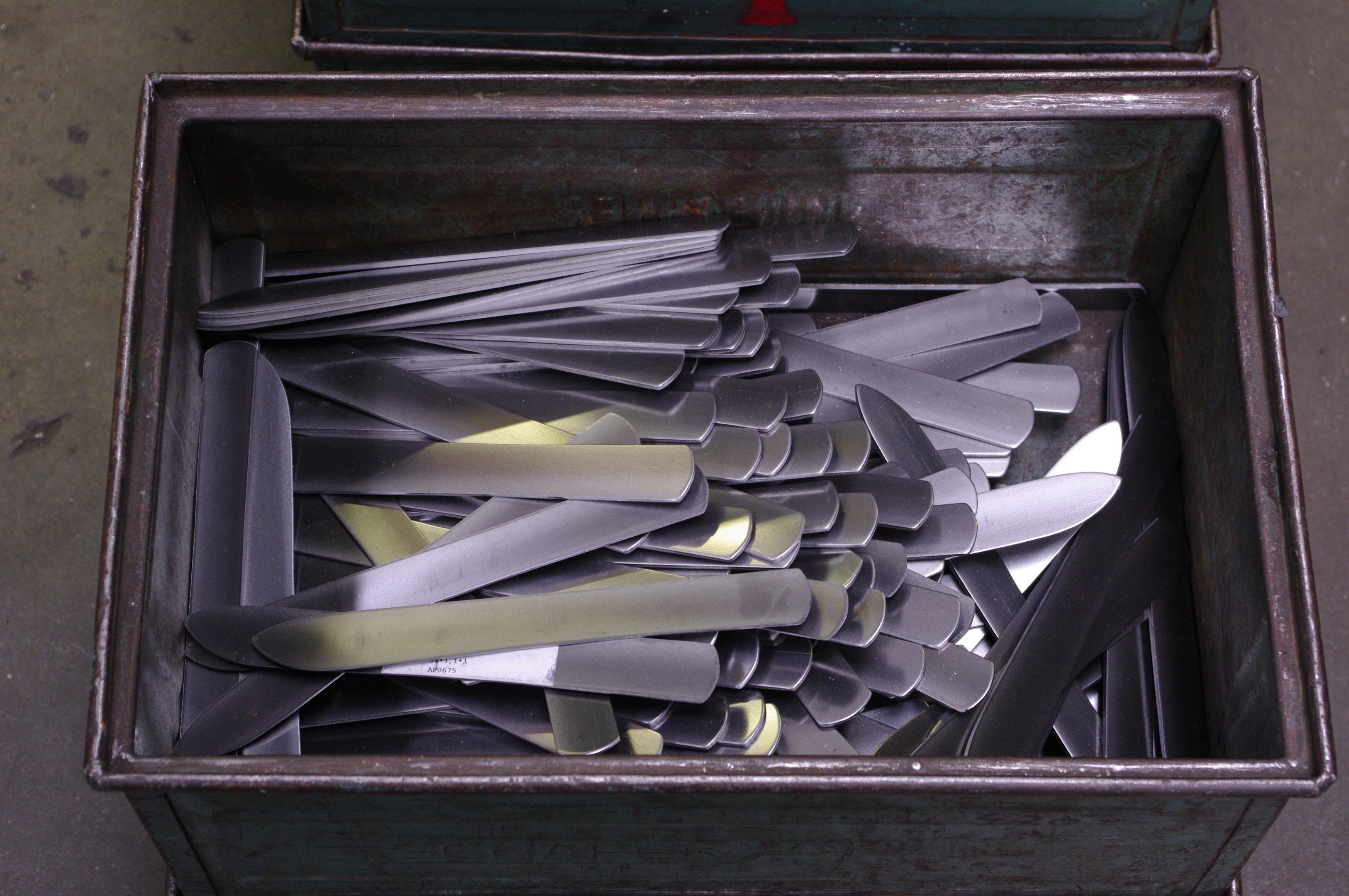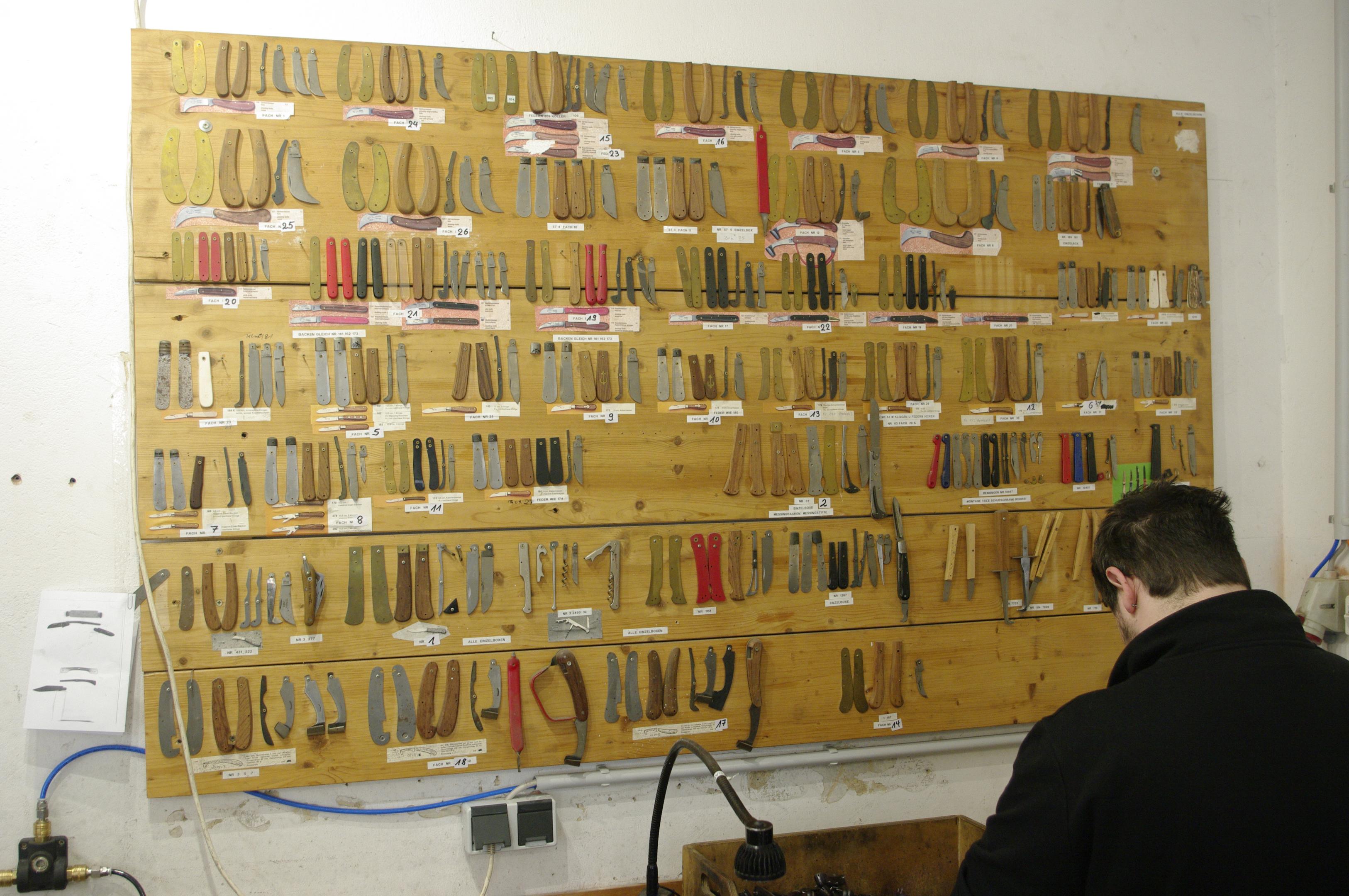Otter-Messer in Solingen
The German city of Solingen remains one of the most important centres of the knife industry. Some of the local companies have been around for more than a hundred years. One of them is Otter-Messer GmbH, which was founded in 1840. European Blades went there for a visit.
Text and pictures: Bas Martens

As the Otter website states: "The OTTER company was founded around 1840 in a small ‘Kotten’ – a traditional grinder’s watermill – at the Königsmühle in Solingen by the Berns brothers. Its name comes from the indigenous otters, which used to live on the riverbanks and streams in the Bergisch Land region in North Rhine-Westphalia, Germany.”
Today's company has many predecessors. It has its origins in a steelware factory established in 1840 by the Berns brothers. The company's name varies from period to period. According to old advertisements, it was called "Gebrüder Berns Otterwerk Stahlwarenfabrik" in 1922, and just "Gebrüder Berns Stahlwarenfabrik" in 1927. The brand name "Otter", depicting an otter with a fish in its mouth, was officially registered in 1899, most likely as a result of the German Warenbezeichnisgesetz from 1894. It is still in use today. The Otter trademark was bought by Rainer Morsbach. As he had no successor, he looked for a takeover candidate around 2010, and that became Frank Rommel.
Rommel is a trained toolmaker who, through his work with a company specialised in garden shears, became involved in cutlery. His dream was to have his own knife-making company and as coincidence would have it, the owner of Otter-Messer at the time had no successors.
The company employs 20 people, including Frank Rommel and his son Alexander. Annually, they produce around 20,000 knives. Hardening is outsourced; sharpening, fitting and finishing of blade and handle is done at Otter itself, using traditional methods.
Today's company has many predecessors. It has its origins in a steelware factory established in 1840 by the Berns brothers. The company's name varies from period to period. According to old advertisements, it was called "Gebrüder Berns Otterwerk Stahlwarenfabrik" in 1922, and just "Gebrüder Berns Stahlwarenfabrik" in 1927. The brand name "Otter", depicting an otter with a fish in its mouth, was officially registered in 1899, most likely as a result of the German Warenbezeichnisgesetz from 1894. It is still in use today. The Otter trademark was bought by Rainer Morsbach. As he had no successor, he looked for a takeover candidate around 2010, and that became Frank Rommel.
Rommel is a trained toolmaker who, through his work with a company specialised in garden shears, became involved in cutlery. His dream was to have his own knife-making company and as coincidence would have it, the owner of Otter-Messer at the time had no successors.
The company employs 20 people, including Frank Rommel and his son Alexander. Annually, they produce around 20,000 knives. Hardening is outsourced; sharpening, fitting and finishing of blade and handle is done at Otter itself, using traditional methods.

Frank Rommel (left) and his son Alexander.
Models
The Otter range consists mainly of pocket knives, with classics such as the 3-Nieten Messer, named after the three rivets which attach the handle scales to the liners. The 3-Nieten knife has a 90 mm blade, either from C75 carbon steel or 1.4034 stainless. The handle scales are either Grenadilla, Smoked Oak or blue stabilised Poplar.
Besides classic models, modern designs include the Finn pocket knife, with an N690 blade only 2 mm thick, and the liner-lock series, designed by Gido Wahrmann. All three models have the same, symmetrical handle, with a Sheepfoot, Rhino and Beluga blade, respectively. Otter also carries a number of models from the Hubertus range.
Otter mainly uses three types of steel: C75 carbon steel, 1.4034 stainless and Carbon Damask. All steels are from local manufacture. The Damask comes from Moorschmied in Solingen. Depending on the model, the knives have handle materials such as wood, bone, antler, copper, brass, stainless steel, Ruthenium and Micarta.



Three models from the Otter model range. From left to right: 3-Nieten Messer, Ankermesser and Mercator K55K.
The Mercator brand
One of Otter's best-known products are the Mercator knives, a brand originally established by the firm Heinrich Kaufmann & Söhne. Mercator is the Latin translation of “trader”, which in turn is the English meaning of Kauffmann. When Kaufmann ceased operations in the 1990s, the Mercator brand was taken over by Otter.
The Mercator pocket knives are made in a small and large version, with a blade length of 85 and 90 mm respectively. The handle has four rivets, the heads of which are rounded by a special machine. The rivet at the end of the handle has a lanyard ring. The most popular version is the original K55K. The model designation stands for "K" for Kaufmann (the original manufacturer), "55" for Hochstrasse 55 (the original company address) and "K" for the symbol of the cat (Katze in German). The embossing is stamped under the press and after powder coating it is painted by hand as in the past. The K55K is made only in a large version, with a 110 mm blade.
Training
Making knives requires craftmanship, as there is a lot of handwork involved. This means you need properly trained personnel. Otter-Messer has an in-house training. This summer, the company had two apprentices, chosen from a larger number of applications. Fortunately, there is no lack of interest. “In a company as ours, you can make something, from the beginning to the end. This gives great job satisfaction”, explains Frank Rommel. Otter also organises school practices from one to three days, were pupils can build a knife.
The pictures give an idea of what Otter-Knives looks like. For their complete assortment, see www.otter-messer.de/en.

Shelving unit with different kinds of steel.

This machine punches out the rough shape of the blade.

Punched blades, ready for further processing.

This machine gives blocks of Micarta the rough shape of the handle scales…

… and these are the Micarta handle scales after their first machining.

Belt grinders are used to shape and polish the handle scales and sharpen and polish the blades.

Boxes full of knives, ready to be shipped.

Mercator knives, ready for inspection. The lower ones have a copper handle.

Handle parts for the Otter classical pocket knife.

Hippekniep knives after sharpening.

A sample board with the parts of Otter knife models.
Making knives requires craftmanship, as there is a lot of handwork involved. This means you need properly trained personnel. Otter-Messer has an in-house training. This summer, the company had two apprentices, chosen from a larger number of applications. Fortunately, there is no lack of interest. “In a company as ours, you can make something, from the beginning to the end. This gives great job satisfaction”, explains Frank Rommel. Otter also organises school practices from one to three days, were pupils can build a knife.
The pictures give an idea of what Otter-Knives looks like. For their complete assortment, see www.otter-messer.de/en.

Shelving unit with different kinds of steel.

This machine punches out the rough shape of the blade.

Punched blades, ready for further processing.

This machine gives blocks of Micarta the rough shape of the handle scales…

… and these are the Micarta handle scales after their first machining.

Belt grinders are used to shape and polish the handle scales and sharpen and polish the blades.

Boxes full of knives, ready to be shipped.

Mercator knives, ready for inspection. The lower ones have a copper handle.

Handle parts for the Otter classical pocket knife.

Hippekniep knives after sharpening.

A sample board with the parts of Otter knife models.